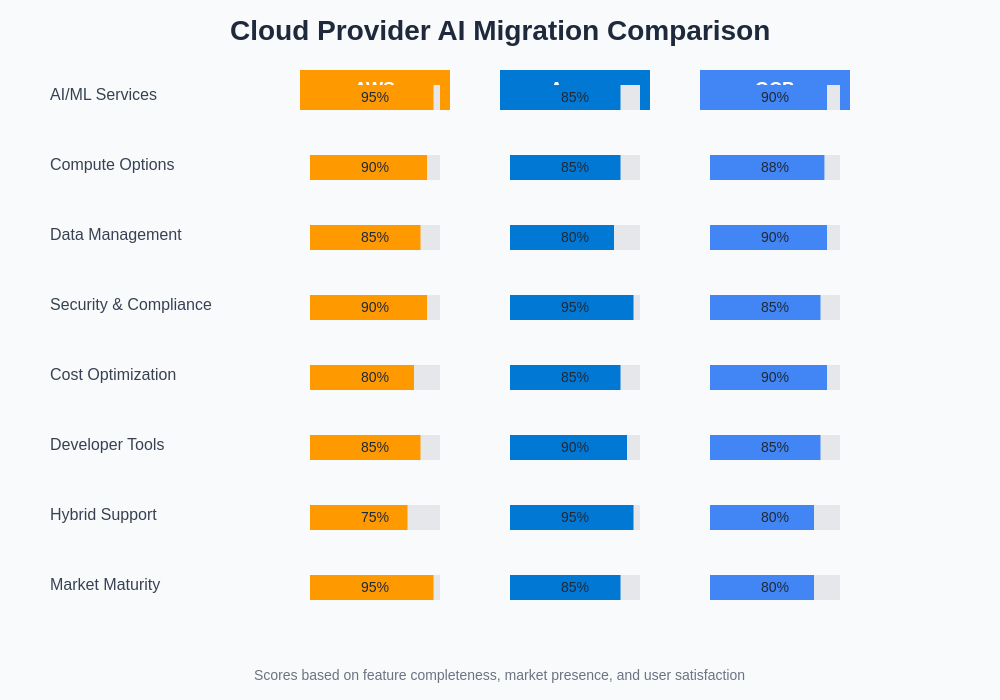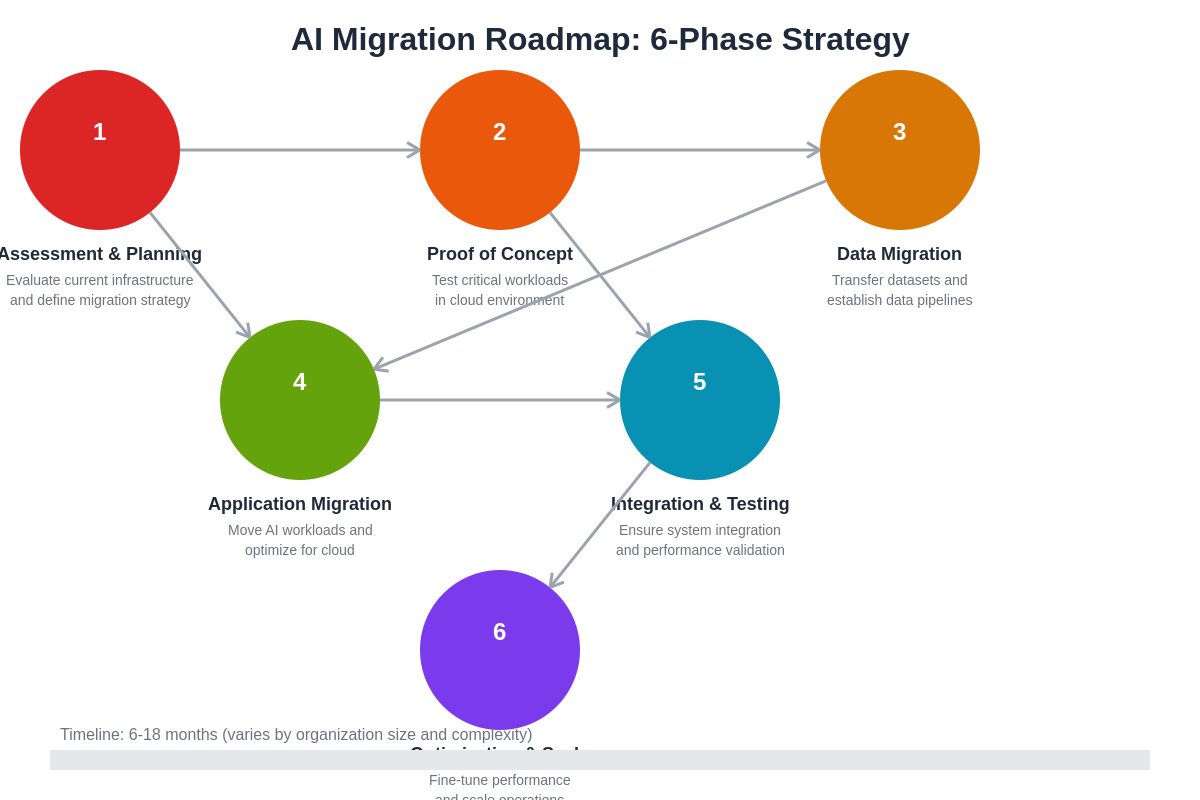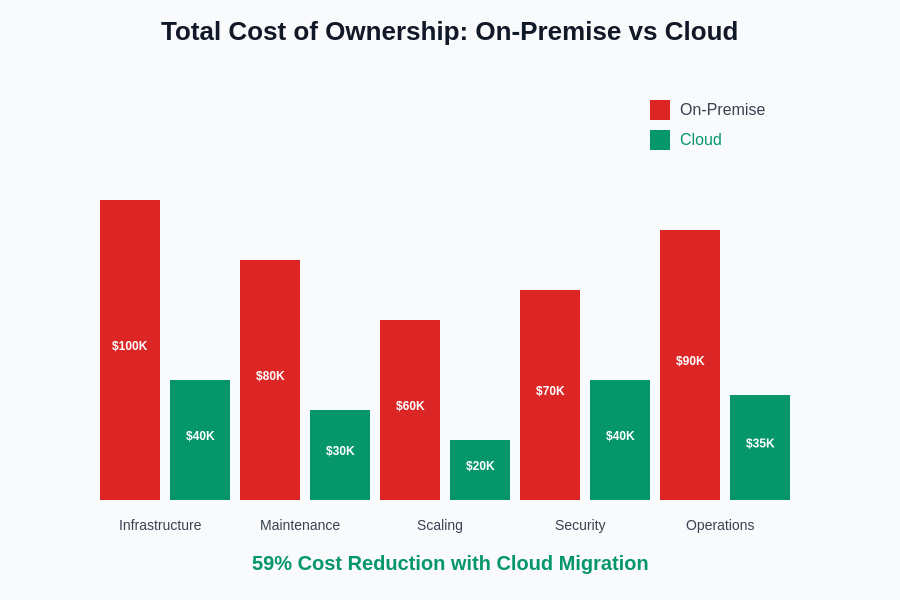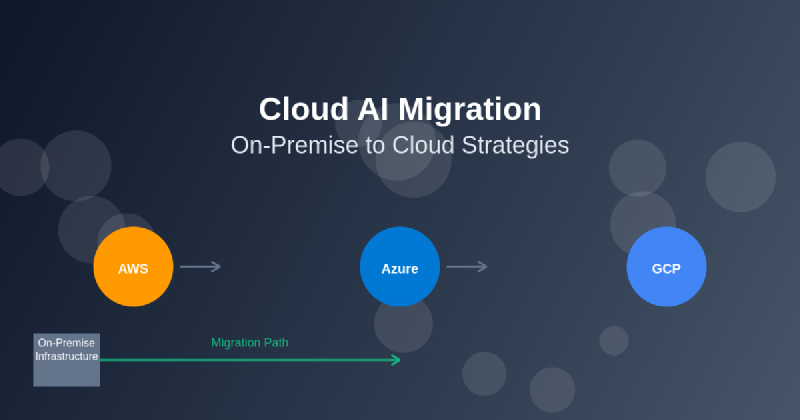The migration of artificial intelligence workloads from on-premise infrastructure to cloud platforms represents one of the most significant strategic decisions facing organizations today. As enterprises increasingly recognize the transformative potential of AI technologies, the limitations of traditional on-premise deployments become apparent, driving the need for scalable, flexible, and cost-effective cloud solutions. This comprehensive exploration examines the strategic considerations, technical challenges, and implementation approaches for migrating AI workloads to Amazon Web Services, Microsoft Azure, and Google Cloud Platform.
Explore the latest AI infrastructure trends to understand how cloud platforms are evolving to support next-generation AI applications and deployment strategies. The journey from on-premise to cloud-based AI infrastructure requires careful planning, strategic thinking, and deep understanding of both current capabilities and future requirements.
Understanding the Cloud AI Migration Imperative
The transition from on-premise AI infrastructure to cloud platforms is driven by fundamental changes in how organizations approach artificial intelligence deployment and scaling. Traditional on-premise solutions, while offering control and security, often struggle with the dynamic resource requirements, rapid scaling needs, and continuous innovation cycles that characterize modern AI applications. Cloud platforms provide elastic computing resources, managed services, and specialized AI tools that can dramatically reduce time-to-market while improving operational efficiency.
Organizations embarking on cloud AI migration must consider multiple factors including existing infrastructure investments, regulatory requirements, data sovereignty concerns, and long-term strategic objectives. The migration process involves not merely transferring workloads but reimagining how AI systems are architected, deployed, and managed to fully leverage cloud-native capabilities and services.
The complexity of AI workloads, with their intensive computational requirements, large dataset dependencies, and specialized hardware needs, makes cloud migration particularly challenging yet potentially rewarding. Successful migration strategies must address technical compatibility, performance optimization, cost management, and organizational change management to ensure seamless transitions that enhance rather than disrupt existing AI capabilities.
AWS AI Migration Strategies and Considerations
Amazon Web Services has established itself as a leading platform for AI workload migration through comprehensive service offerings, mature infrastructure, and extensive partner ecosystems. AWS provides multiple pathways for organizations migrating AI workloads, ranging from simple lift-and-shift approaches to complete application modernization using cloud-native AI services. The platform’s strength lies in its breadth of compute options, including specialized instances optimized for machine learning workloads, comprehensive data storage solutions, and managed services that reduce operational overhead.
Organizations considering AWS for AI migration should evaluate Amazon SageMaker as a central platform for machine learning development, training, and deployment. SageMaker provides integrated development environments, automated model tuning capabilities, and scalable inference endpoints that can significantly simplify the migration of complex AI workflows. The platform supports multiple machine learning frameworks and provides pre-built algorithms that can accelerate development cycles while reducing infrastructure management requirements.
Enhance your cloud strategy with advanced AI capabilities to leverage sophisticated reasoning and analysis tools for migration planning and implementation. The integration of AWS with external AI services can provide additional capabilities for migration assessment, optimization, and ongoing management of cloud-based AI workloads.
AWS migration strategies should consider the platform’s extensive security and compliance frameworks, which are particularly important for organizations in regulated industries. The ability to maintain data residency requirements, implement fine-grained access controls, and achieve various compliance certifications makes AWS suitable for sensitive AI workloads that require strict security and regulatory adherence.

The comparative analysis of major cloud platforms reveals distinct strengths and considerations for AI workload migration. Each provider offers unique advantages in different areas, making the selection process dependent on specific organizational requirements, existing technology investments, and strategic objectives.
Microsoft Azure AI Migration Approach
Microsoft Azure presents compelling advantages for organizations already invested in Microsoft technologies, offering seamless integration with existing enterprise software stacks and familiar development environments. Azure’s AI migration strategy centers around Azure Machine Learning, a comprehensive platform that provides end-to-end machine learning lifecycle management, from data preparation through model deployment and monitoring. The platform’s integration with popular development tools like Visual Studio and strong support for open-source frameworks makes it particularly attractive for organizations with existing Microsoft infrastructure.
Azure’s hybrid cloud capabilities represent a significant advantage for organizations requiring gradual migration approaches or those with regulatory constraints that prevent complete cloud adoption. Azure Arc extends Azure services to on-premise and multi-cloud environments, enabling organizations to maintain unified management and governance across hybrid deployments. This capability is particularly valuable for AI workloads that require phased migration or continued on-premise processing for sensitive data.
The platform’s cognitive services and pre-built AI models provide opportunities for organizations to enhance existing applications with AI capabilities without extensive custom development. These services can serve as stepping stones for broader AI adoption while organizations plan more comprehensive migration strategies for custom machine learning workloads.
Azure’s strong integration with Microsoft’s productivity and collaboration tools creates opportunities for AI-enhanced business processes that extend beyond traditional machine learning applications. Organizations can leverage this integration to create comprehensive digital transformation strategies that encompass both AI migration and broader workplace modernization initiatives.
Google Cloud Platform AI Migration Excellence
Google Cloud Platform distinguishes itself through its deep expertise in artificial intelligence and machine learning, leveraging Google’s extensive experience in developing and deploying AI technologies at scale. GCP’s AI migration strategies benefit from the platform’s robust data analytics capabilities, advanced machine learning tools, and cutting-edge research in artificial intelligence. The platform’s strength in handling large-scale data processing makes it particularly suitable for organizations with extensive datasets and complex analytical requirements.
Google Cloud’s AI Platform provides comprehensive tools for machine learning development, training, and deployment, with particular strengths in areas such as natural language processing, computer vision, and recommendation systems. The platform’s AutoML capabilities enable organizations to develop custom machine learning models with minimal expertise, reducing barriers to AI adoption and accelerating migration timelines.
The platform’s emphasis on open-source technologies and standards provides flexibility for organizations concerned about vendor lock-in, while its advanced networking capabilities support complex multi-region deployments and hybrid cloud architectures. GCP’s commitment to sustainable computing and carbon-neutral operations also appeals to organizations with environmental sustainability objectives.
Leverage comprehensive research capabilities with Perplexity to gather detailed information about specific GCP services and migration requirements for your particular AI workloads. The platform’s continuous innovation in AI research and development provides organizations with access to cutting-edge capabilities that may not be available on other cloud platforms.
Multi-Cloud and Hybrid Migration Strategies
The complexity and diversity of modern AI workloads often require sophisticated deployment strategies that span multiple cloud platforms and maintain connections to on-premise infrastructure. Multi-cloud approaches can provide organizations with greater flexibility, risk mitigation, and access to specialized services that may be unique to particular platforms. However, multi-cloud strategies also introduce complexity in terms of data management, security, and operational overhead that must be carefully managed.
Hybrid cloud strategies are particularly relevant for AI workloads that involve sensitive data, regulatory constraints, or existing infrastructure investments that cannot be easily migrated. These approaches enable organizations to maintain critical processing capabilities on-premise while leveraging cloud resources for scalable compute, advanced AI services, and development environments. The key to successful hybrid AI deployment lies in creating seamless data pipelines, consistent security policies, and unified management interfaces across all deployment environments.
Organizations pursuing multi-cloud or hybrid strategies must invest in robust orchestration and management tools that can provide visibility and control across diverse infrastructure environments. Container technologies, particularly Kubernetes, play crucial roles in enabling portable AI workloads that can be deployed consistently across different cloud platforms and on-premise environments.

The structured approach to AI migration follows a systematic six-phase methodology that ensures comprehensive planning, risk mitigation, and successful implementation. This roadmap provides organizations with a clear framework for managing the complexity of transitioning AI workloads from on-premise infrastructure to cloud platforms.
Data Migration and Management Considerations
The success of AI workload migration heavily depends on effective data migration and management strategies, as AI systems typically require access to large volumes of training data, real-time input streams, and historical datasets for ongoing operations. Cloud migration provides opportunities to modernize data architectures, implement more sophisticated data governance practices, and leverage advanced analytics capabilities that may not be available in on-premise environments.
Data migration strategies must consider factors such as transfer costs, bandwidth limitations, security requirements, and ongoing synchronization needs between on-premise and cloud environments. Organizations should evaluate different migration approaches including offline data transfer services, dedicated network connections, and incremental synchronization strategies to minimize disruption and optimize costs.
Cloud platforms provide advanced data management services including data lakes, data warehouses, and streaming analytics platforms that can significantly enhance AI capabilities beyond what was possible in on-premise environments. However, these services require careful planning to ensure optimal performance, cost-effectiveness, and compliance with data governance requirements.
Security and Compliance in Cloud AI Migration
Security considerations are paramount in AI workload migration, particularly for organizations handling sensitive data or operating in regulated industries. Cloud platforms provide extensive security capabilities including encryption, identity management, network security, and compliance frameworks that often exceed what organizations can implement in on-premise environments. However, migrating to the cloud also introduces new security considerations including shared responsibility models, data sovereignty, and third-party access that must be carefully addressed.
Compliance requirements add additional complexity to AI migration strategies, as organizations must ensure that cloud deployments meet industry-specific regulations, data protection requirements, and international standards. Cloud platforms provide various compliance certifications and tools to support regulatory adherence, but organizations must carefully evaluate how these capabilities align with their specific compliance obligations.
The shared responsibility model inherent in cloud computing requires organizations to clearly understand their security obligations versus those handled by cloud providers. This understanding is particularly important for AI workloads that may process sensitive information or operate in mission-critical environments where security breaches could have significant business impacts.
Cost Optimization and Financial Management
Cost management represents a critical consideration in cloud AI migration, as AI workloads can be resource-intensive and costs can scale rapidly without proper monitoring and optimization. Cloud platforms provide various pricing models including on-demand, reserved capacity, and spot instances that can significantly impact overall costs depending on usage patterns and workload characteristics. Organizations must develop sophisticated cost management strategies that balance performance requirements with budget constraints.
The variable cost structure of cloud computing can provide significant advantages for AI workloads with fluctuating resource requirements, but it also requires more active cost monitoring and management compared to fixed on-premise infrastructure costs. Organizations should implement cost allocation, budgeting, and optimization tools to maintain visibility and control over cloud spending while ensuring adequate resources for AI workload performance.
Cloud migration also provides opportunities to optimize costs through more efficient resource utilization, automated scaling, and access to specialized hardware that may be cost-prohibitive in on-premise deployments. However, realizing these cost benefits requires careful architecture design and ongoing optimization efforts to ensure resources are appropriately sized and utilized.

The total cost of ownership analysis demonstrates significant potential savings across multiple categories when migrating AI workloads to cloud platforms. Organizations can achieve substantial cost reductions while gaining access to advanced capabilities and improved operational efficiency through strategic cloud adoption.
Performance Optimization and Scaling Strategies
AI workloads present unique performance challenges that require careful consideration during cloud migration, including computational intensity, memory requirements, network bandwidth needs, and specialized hardware dependencies. Cloud platforms provide various compute options optimized for different AI workload types, including GPU instances for training deep learning models, TPU instances for TensorFlow workloads, and high-memory instances for large-scale data processing.
Migration strategies must consider how to optimize performance while managing costs, often requiring trade-offs between compute power, memory capacity, and network performance. Organizations should conduct thorough performance testing and benchmarking to understand how their AI workloads perform in different cloud configurations and identify optimal resource allocation strategies.
Auto-scaling capabilities provided by cloud platforms can significantly improve resource utilization and cost-effectiveness for AI workloads with variable demand patterns. However, implementing effective auto-scaling requires careful configuration of scaling policies, performance metrics, and resource allocation strategies to ensure adequate performance while avoiding unnecessary costs.
Organizational Change Management and Skills Development
Cloud AI migration requires significant organizational change management, as teams must adapt to new tools, processes, and operational models. Organizations must invest in training and skills development to ensure teams can effectively utilize cloud platforms and AI services while maintaining security, performance, and cost optimization objectives. This investment includes both technical training on specific cloud platforms and broader education on cloud-native architectures and best practices.
The shift to cloud-based AI development often requires changes in development methodologies, deployment processes, and operational procedures. Organizations should plan for these changes and provide adequate support and resources to ensure smooth transitions. Change management strategies should include clear communication about migration objectives, timelines, and expected outcomes to maintain stakeholder support and engagement.
Cultural changes may also be required as organizations transition from traditional IT operations focused on infrastructure management to cloud-native approaches emphasizing service utilization, automation, and continuous optimization. These cultural shifts require leadership support and ongoing reinforcement to ensure successful adoption of cloud-based AI capabilities.
Future-Proofing and Innovation Strategies
Cloud AI migration provides organizations with opportunities to future-proof their AI capabilities by leveraging continuous innovation and service evolution provided by cloud platforms. Cloud providers regularly introduce new AI services, improved performance capabilities, and enhanced tools that can benefit migrated workloads without requiring additional infrastructure investments or major system changes.
Organizations should consider how their migration strategies align with emerging trends in AI technology including edge computing, federated learning, and advanced neural network architectures. Cloud platforms are increasingly providing capabilities to support these trends, and migration strategies should position organizations to take advantage of future innovations.
The rapid pace of innovation in AI technology makes flexibility and adaptability crucial considerations in migration planning. Organizations should avoid vendor lock-in strategies that may limit their ability to adopt new technologies or migrate to different platforms as their requirements evolve. This consideration includes evaluating open standards support, data portability, and integration capabilities across different cloud platforms and services.
Cloud AI migration represents a transformative opportunity for organizations to enhance their artificial intelligence capabilities while improving scalability, flexibility, and cost-effectiveness. Success requires careful planning, strategic thinking, and ongoing optimization to ensure that migrated workloads fully leverage cloud capabilities while meeting performance, security, and compliance requirements. The future of AI lies in cloud-native architectures that can adapt to changing requirements and leverage continuous innovation provided by leading cloud platforms.
Disclaimer
This article is for informational purposes only and does not constitute professional advice. The views expressed are based on current understanding of cloud computing technologies and AI migration strategies. Readers should conduct their own research and consult with qualified professionals when planning cloud migration projects. The effectiveness of migration strategies may vary depending on specific organizational requirements, existing infrastructure, and business objectives. Cloud platform capabilities and pricing are subject to change and should be verified directly with providers.
